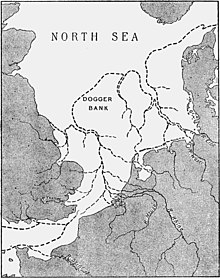Clement Reid
Clement Reid (born January 6, 1853 in London , † December 10, 1916 in Milford-on-Sea ) was a British paleobotanist and geologist . His botanical author's abbreviation is " C. Reid ".
Reid came from a modest background and was mainly self-taught. His great-uncle was Michael Faraday . From 1874 he was employed as a field geologist at the Geological Survey with geological mapping. In 1901 he became a district geologist. In 1913 he retired.
In 1908 he was a geologist in Cyprus to advise on the use of water resources.
In 1875 he became a fellow of the Geological Society of London , in whose council he was from 1892 to 1895 and 1912 and whose Murchison Fund scholarship he received in 1886 and whose Bigsby Medal in 1897. 1913/14 he was its vice-president. In 1899 he became a Fellow of the Royal Society . He was a fellow of the Linnean Society and 1900 to 1902 and 1905 to 1907 in their council. He was Secretary of the British Association's Geology Department.
He was particularly concerned with the tertiary and was a pioneer of paleobotany. In thorough investigations (partly in the Netherlands in Tegelen (1905)) he showed that the fossil flora of certain deposits could be reconstructed almost exclusively from seeds and pollen .
He was married to Eleanor Mary Reid since 1897 , with whom he moved to Milford-on-Sea in Hampshire in 1913 and with whom he worked closely and published.
At the end of the 19th century he systematically worked on fossil finds from the North Sea and suspected an ice age land mass that is now covered by the North Sea (in the area of the Dogger Bank ) that connected Great Britain with Europe (see Doggerland ). He wrote about it in his book Submerged Forests .
He also published on Man in the Ice Age (Report on Relation of Palaeolithic Man to the Glacial Epoch ( Hoxne Excavation), British Association 1896).
Fonts
- The origin of the british flora , London, Dulau 1899, Archive.org doi: 10.5962 / bhl.title.24157 doi: 10.5962 / bhl.title.55460 doi: 10.5962 / bhl.title.7595
- The Pliocene deposits of Britain , Geological Survey, London, Printed for HM Stationery Office by Eyre and Spottiswoode, 1890
- Submerged Forests , Cambridge University Press and Putnam's (New York), 1913, Archives
- with Eleanor Mary Reid: The Pliocene floras of the Dutch-Prussian border , Mededeelingen van de Rijksopsporing van Delfstoffen, No. 6, Gravenhage , M. Nijhoff 1915 doi: 10.5962 / bhl.title.57075
- with Eleanor Mary Reid: The fossil flora of Tegelen-sur-Meuse, near Venloo, in the Province of Limburg , Verh. Kgl. Akad. Wet. Amsterdam 1907
At the Geological Survey he published reports on the geology of Bournemouth (1898), Eastbourne (1898), Holderness (and adjacent parts of Yorkshire and Lincolnshire, 1885), Dorchester (1899), Ringwood (1902), Salisbury (1903), Bognor ( 1897), Cromer (1882), Chichester (1903), Southampton (1902) and the tertiary section of the Isle of Wight (1899).
literature
- Obituary, Proceedings of the Royal Society of London, Series B, Volume 90, 1919, pp. Viii-x.
- RC Preece, IJ Killeen Edward Forbes (1815-1854) and Clement Reid (1853-1916): two generations of pioneering polymaths , Archives of Natural History, Volume 22, 1995, 419-435.
- Obituary in Journal of Botany, Volume 55, 1917, pp. 145-151.
Web links
- Biography of Clement Reid
- Author entry and list of the plant names described for Clement Reid at the IPNI
| personal data | |
|---|---|
| SURNAME | Reid, Clement |
| ALTERNATIVE NAMES | Reid, Clement L .; C. Reid (botanical author abbreviation) |
| BRIEF DESCRIPTION | British paleobotanist and geologist |
| DATE OF BIRTH | January 6, 1853 |
| PLACE OF BIRTH | London |
| DATE OF DEATH | December 10, 1916 |
| Place of death | Milford-on-Sea |

